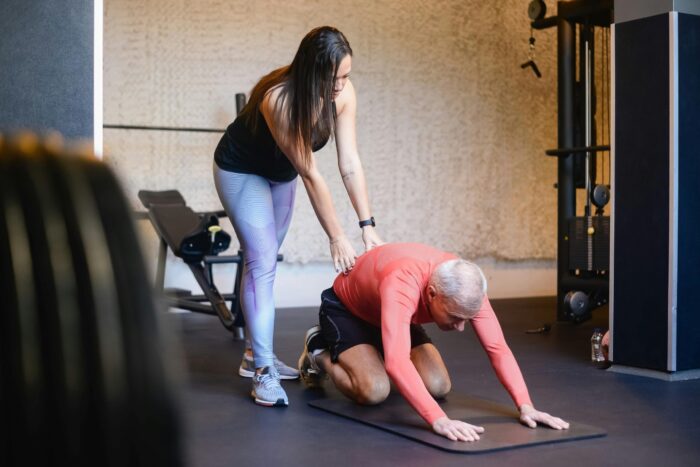Is It Possible To Shrink In Height As You Get Older?
Yes, it is possible to shrink in height as you get older. This phenomenon is primarily due to changes in the spine, such as the compression of vertebrae and the loss of fluid in intervertebral discs. Other factors include muscle loss, poor posture, and conditions like osteoporosis, which cause bones to become brittle and weak. Maintaining good bone and spine health through a balanced diet, regular exercise, and healthy lifestyle choices can help minimize height loss and support overall well-being as you age.

As people age, it’s common for them to lose height. This phenomenon, often referred to as “shrinking,” is primarily due to changes in the bones, muscles, and joints of the spine. While a certain amount of height loss is normal, excessive shrinking can indicate underlying health issues, particularly related to bone and spinal health. Understanding the causes and implementing strategies to maintain bone and spine health can significantly improve quality of life for seniors.
Causes of Height Shrinkage
- Vertebral Compression: The vertebrae in the spine can become compressed over time. This is often due to osteoporosis, a condition where bones become brittle and fragile.
- Disc Degeneration: The intervertebral discs, which act as cushions between the vertebrae, lose fluid and flexibility with age, leading to a reduction in height.
- Postural Changes: Poor posture, muscle weakness, and degenerative changes in the spine can lead to a stooped posture, contributing to height loss.
- Muscle Loss: Sarcopenia, or age-related muscle loss, can also affect posture and spinal support, leading to height reduction.
Strategies to Maintain Bone and Spine Health
Diet and Nutrition: A balanced diet rich in calcium and vitamin D is essential for bone health. Calcium is crucial for bone strength, while vitamin D helps the body absorb calcium. Foods such as dairy products, leafy greens, and fortified foods are excellent sources of these nutrients. Additionally, magnesium, vitamin K, and protein are important for maintaining healthy bones.
Regular Exercise: Weight-bearing exercises, such as walking, jogging, and resistance training, can help maintain bone density and strength. Activities that improve balance and posture, like yoga and tai chi, can also enhance spinal health and prevent falls. Incorporating stretching exercises can improve flexibility and reduce the risk of spinal compression.
Healthy Lifestyle Choices: Avoiding smoking and excessive alcohol consumption is crucial, as these habits can weaken bones and reduce bone density. Maintaining a healthy weight is also important to avoid excessive stress on the spine and joints.
Bone Density Testing: Regular bone density tests can help detect osteoporosis early. Early detection allows for timely intervention to prevent further bone loss and fractures. Seniors should discuss with their healthcare providers the appropriate timing for these tests based on their individual risk factors.
Medications and Supplements: In some cases, medications such as bisphosphonates may be prescribed to prevent bone loss. Supplements, including calcium and vitamin D, can also be beneficial, especially if dietary intake is insufficient. It’s important to consult with a healthcare provider before starting any new medication or supplement regimen.
Ergonomics and Posture: Maintaining good posture is essential for spinal health. Ergonomic adjustments, such as using supportive chairs and proper lifting techniques, can reduce the risk of spinal injuries. Practicing good posture habits, like standing tall and aligning the ears with the shoulders, can prevent postural changes that contribute to height loss.
Fall Prevention: Falls are a significant risk factor for fractures in seniors. Implementing fall prevention strategies, such as removing tripping hazards, using handrails, and wearing supportive footwear, can help reduce the risk of falls and subsequent bone injuries.
Physical Therapy: Physical therapy can provide personalized exercise programs to strengthen the muscles supporting the spine, improve posture, and increase flexibility. Therapists can also teach techniques to safely perform daily activities and reduce the risk of injury.
Adequate Sleep: Quality sleep is essential for overall health, including bone and spinal health. During sleep, the body repairs and regenerates tissues, including bones. Ensuring a comfortable sleep environment and maintaining a regular sleep schedule can contribute to better health outcomes.
Stress Management: Chronic stress can negatively impact bone health by increasing the production of cortisol, a hormone that can lead to bone loss. Engaging in stress-reducing activities such as meditation, deep breathing exercises, and hobbies can promote overall well-being and bone health.
What are 5 exercises that increase bone density?
Here are five exercises that can help increase bone density:
1. Weight-Bearing Exercises
Examples: Walking, jogging, and hiking. Benefits: These exercises force your bones to work against gravity, stimulating bone formation and increasing bone density. Regular walking or jogging can significantly improve the strength of your lower body bones, including your hips and legs.
2. Resistance Training
Examples: Weight lifting, resistance band exercises. Benefits: Lifting weights or using resistance bands puts stress on your bones, prompting them to become denser. Exercises such as squats, lunges, and bench presses are effective for strengthening various bones, including those in the arms, legs, and spine.
3. High-Impact Aerobics
Examples: Dancing, step aerobics. Benefits: High-impact activities create stress on the bones in your legs, hips, and lower spine, promoting bone density. These activities can be fun and engaging while providing significant bone-strengthening benefits.
4. Balance and Stability Exercises
Examples: Tai chi, yoga. Benefits: While not high-impact, these exercises improve balance and coordination, reducing the risk of falls and fractures. Yoga poses that require you to support your weight, such as tree pose or warrior pose, also help strengthen bones.
5. Stair Climbing
Examples: Using stairs instead of elevators, stair-climbing machines. Benefits: Climbing stairs is a weight-bearing exercise that works against gravity, increasing bone density in your legs and hips. It’s a simple yet effective way to incorporate bone-strengthening activities into your daily routine.
Conclusion
Height loss in seniors is a common occurrence, but it can be minimized with proactive measures to maintain bone and spine health. A holistic approach that includes a nutritious diet, regular exercise, healthy lifestyle choices, and medical interventions can help seniors maintain their height and overall quality of life. By prioritizing bone and spinal health, seniors can reduce the risk of fractures, maintain mobility, and enjoy a better quality of life in their later years.
Related Articles

What is Palliative Care?
Palliative care is a specialized medical care approach focused on providing relief from the symptoms and stress of a serious illness.

Understanding Assisted Living
Assisted living provides older adults with a residential option that combines housing, personal care, and health services.

Introduction to Nursing Homes
Assisted living offers daily support and independence; nursing homes provide 24/7 medical care;

Benefits of Yoga for Seniors
Discover how yoga can enhance flexibility, balance, and mental well-being





